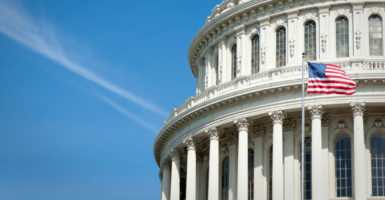The Congressional Budget Office has released a new report estimating the impact that last year’s reconciliation bill (H.R. 3762), which repealed a lot of Obamacare’s major provisions, would have on coverage and premiums.
At first glance, the estimates are daunting—but when put into the context of reality, they have little meaning.
Last year’s reconciliation bill repealed Obamacare’s enhanced funding for Medicaid expansion and the subsidies for exchange enrollees, with a two-year delay. The CBO estimates that in the first plan year after enactment, this would increase the number of uninsured by 18 million.
In addition, the CBO estimates that premiums in the individual market would increase by 20-25 percent. The CBO projects there would be even further increases in the number of uninsured and the cost of premiums after the bill’s two-year transition period comes to an end.
The CBO says: “Following enactment but before the Medicaid expansion and subsidies for insurance purchased through the marketplaces were eliminated, the effects of H.R. 3762 on insurance coverage and premiums would stem primarily from repealing the penalties associated with the individual mandate.“ (Emphasis added).
Thus, the CBO’s estimate relies on the assumption that Obamacare’s individual mandate is highly effective in getting people to purchase coverage. That assumption is questionable.
Earlier this month, the IRS told Congress that about 6.5 million taxpayers had decided to pay the individual mandate penalty rather than sign up for Obamacare’s expensive coverage in 2015, and that another 12.7 million taxpayers claimed an exemption from the mandate.
So with more than 19 million taxpayers skirting the mandate’s effects, it’s questionable how many people the mandate is really forcing to buy coverage.
In addition, the CBO’s projection is implicitly saying that without mandates and subsidies to purchase coverage, Obamacare’s policies destroy the individual health insurance market—something critics of Obamacare have been saying all along.
The CBO even agrees, stating, “The number of people without health insurance would be smaller if, in addition to the changes in H.R. 3762, the insurance market reforms mentioned above were also repealed.”
But most importantly, this CBO estimate is based on the impact of a repeal-only bill, and a partial repeal at that. As Senate Majority Leader Mitch McConnell’s spokesperson said, “This report assumes a situation that simply doesn’t exist and that no one in Congress advocates.”
Republicans have promised for the last six years to entirely repeal and replace Obamacare. But because the reconciliation process only allows for a partial repeal of Obamacare, harmful and costly federal insurance regulations will be left in place until Congress comes back to repeal the remainder of the law.
Repeal through reconciliation is a necessary and critical first step in repealing Obamacare, but it is just part of the repeal process.
Moreover, Republicans have always planned to replace Obamacare with reforms that make insurance accessible to everyone and that reduce health care costs.
Just last week, House Speaker Paul Ryan, R-Wis., told Americans that many elements of the Republican replace plan will be included in the repeal bill that Congress plans to pass in the coming weeks.
Of course, a CBO projection of the repeal-only bill could not take these key elements into account. But the reality is that the impact of a replacement plan, executive actions to alleviate Obamacare’s burden, as well as the repeal of Obamacare’s remaining provisions will lead to very different CBO projections regarding coverage and premium costs.



























